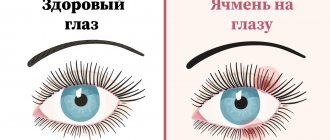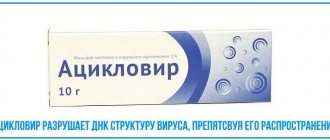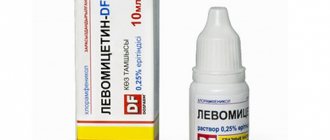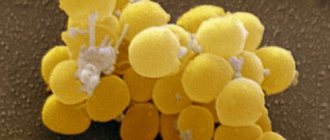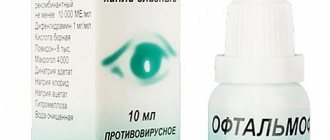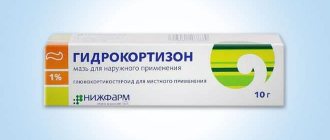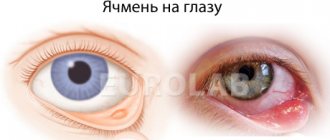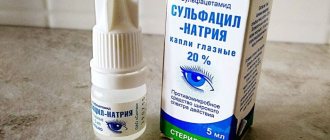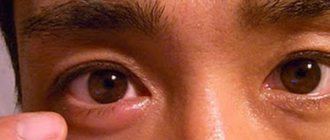Barley or, as it is also called, meibomite, is a purulent ophthalmological disease that is accompanied by inflammation of the sebaceous gland or hair follicle of the eyelash. The disease can be either external or internal, affecting the upper or lower eyelid. At the same time, the appearance of stye is accompanied by unpleasant symptoms in the form of itching, redness or pain in the eye area, so many people wonder: how to treat internal stye on the upper eyelid?
Internal stye on the upper eyelid
Causes
- 6.1 Video: How to get rid of stye
The main reason for the appearance of stye on the lower or upper eyelid is an infection, which, penetrating into the eyeball from the external environment, leads to the proliferation of bacteria.
Internal stye on the lower eyelid
There are other factors that contribute to the occurrence of pathology:
- prolonged exposure to low temperatures on the organs of vision;
- failure to comply with personal hygiene rules;
- violation of the rules for using contact lenses;
- reduced immune system;
- consequences of previous illnesses;
- frequent eye exposure to smoke, sand or dust;
- development of seborrhea (skin disease accompanied by disruption of the sebaceous glands);
Dry seborrhea
- disruption of the meibomian glands;
- problems with the functioning of the gastrointestinal tract;
- mechanical damage to the skin of the outer ear or face;
- the development of an inflammatory process affecting the outer and inner surface of the eyelids;
- hormonal imbalance;
- diabetes;
- problems with the functioning of the endocrine glands.
Stye on the eye
On a note! The use of low-quality cosmetics, in particular mascara or shadow, can also provoke the development of the disease. Low-quality products lead to the development of an allergic reaction, manifested in the form of barley.
Top 4. Signitsef
Rating (2020): 4.33
125 reviews from resources were taken into account: Yandex.Market, Otzovik, Doctors.rf, Otabletkah, Protabletky
- Characteristics
- Average price: 225 rub. (5 ml)
- Manufacturer: Sentiss Pharma (India)
- Active ingredient: levofloxacin
Signicef eye drops contain levofloxacin as an active ingredient, which has antibacterial activity against a wide range of pathogens. The drug belongs to the category of third-generation fluoroquinolones and is quite safe and effective. Children can use it after the first year of life. On the first day of treatment for barley, Signicef can be instilled every two hours, which allows you to quickly improve the condition. The bottle is small, only 5 ml, but it is enough for one course of treatment. Once opened, the shelf life is limited to one month. The drops receive good reviews, not only from ordinary people, but also from doctors.
Advantages and disadvantages
- Broad-spectrum antibacterial drops
- Possible for children from one year old
- Relief already on the first day of use
- There are side effects such as burning and itching
- An open bottle cannot be stored for longer than a month.
Characteristic symptoms
In most cases, the development of stye is accompanied by a feeling of sand or dryness in the eye, but as the inflammatory process develops, the patient may experience other symptoms. The clinical picture of internal stye looks something like this:
- enlarged lymph nodes, increased body temperature, headache and other signs of a severe inflammatory process;
Healthy eye, internal and external stye
- a yellow formation on the inside of the eyelid, the size of which, as a rule, does not exceed the size of a pea. The formation can also be painted white;
- swelling and redness of the mucous membrane;
- swelling of the conjunctiva;
- painful sensations on palpation;
- inflammation of the extreme part of the upper eyelid;
- the acute development of the pathological process is accompanied by severe pain in the area of the affected eye.
Stye on the upper eyelid
The duration of symptoms can be 2-3 days, after which the resulting barley opens inside. In rare cases, inflammation becomes chronic, but the size of the suppuration decreases. To quickly and permanently get rid of the unpleasant symptoms of stye, you first need to establish the exact causative factors, so at the first signs you need to consult a doctor for an examination.
Top 1. Levomycetin
Rating (2020): 4.62
426 reviews from resources were taken into account: Yandex.Market, Otzovik, Otabletkah, Protabletky
- Nomination
Best price Levomycetin eye drops are the most affordable treatment for styes and the winner in the “Best Price” category.
- Characteristics
- Average price: 19 rub. (10 ml)
- Manufacturer: Slavyanskaya Pharmacy (Russia)
- Active ingredient: chroramphenicol
Levomycetin – broad-spectrum drops. Their main component is chloramphenicol, which effectively copes with many infectious diseases. When used topically, these eye drops have a comprehensive effect on the problem, speed up recovery and alleviate the course of the disease. The product has disinfectant properties, so the likelihood of infection of the conjunctiva is completely excluded. Drops relieve pain, prevent suppuration and swelling. Levomycetin is evenly distributed over the surface of the eye, but may cause a slight burning sensation. The only negative is a wide list of contraindications, including pregnancy, lactation, psoriasis.
Advantages and disadvantages
- Affordable price
- Sold in every pharmacy
- Relieves pain and inflammation, speeds up recovery
- There are contraindications
- Possible individual side effects
- Some release forms do not have a dispenser
See also:
- 12 best drops for conjunctivitis
to the beginning of the rating
Diagnostic features
Examination of the patient's eye
As a rule, to diagnose a pathology, it is enough for an ophthalmologist to conduct a visual examination, but in rare cases, additional diagnostic examinations and tests are prescribed:
- immunogram (analysis performed to assess the state of immunity);
- laboratory analysis for staphylococcus - the main causative agent of meibomitis;
- general blood analysis;
- measuring blood sugar levels using a special device - a glucometer.
Glucometer
Based on the results of the tests, the doctor will be able to determine the stage and cause of the disease. Only after this the patient is prescribed an appropriate course of therapy.
Top 2. Okomistin
Rating (2020): 4.59
205 reviews from resources were taken into account: Yandex.Market, Otzovik, Doctors.rf, Otabletkah, Protabletky
- Nomination
Comprehensive solution to the problem Okomistin drops have antimicrobial, antiseptic, anti-inflammatory, immunomodulatory and regenerating effects, and take a comprehensive approach to the problem of treating barley.
- Characteristics
- Average price: 186 rub. (10 ml)
- Manufacturer: Infamed (Russia)
- Active ingredient: benzyldimethyl-myristoylamino-propylammonium
Okomistin eye drops have a pronounced antiseptic and antimicrobial effect. The product is effective against most pathogens of barley, including staphylococcus and streptococcus. The medicine helps reduce bacterial resistance to antibiotics. In addition to relieving inflammation, Okomistin is able to increase local immunity and regenerate tissue. To treat stye, drops can be used in both adults and children. Improvements come quickly, literally in a couple of days, especially if treatment is started at the initial stage of the disease. The medicine is relatively inexpensive, but it is a little inconvenient that after opening it can only be used for a month.
Advantages and disadvantages
- Not an antibiotic
- Effective for both treatment and prevention
- Can be used for both adults and children
- Relief occurs in just a couple of days
- Reduces bacterial resistance to antibiotics
- Unpleasant sensations after instillation
- In rare cases, an individual allergic reaction occurs
Treatment methods
To treat internal stye, various methods can be used, starting with physiotherapy or pharmaceuticals, and ending with proven recipes of traditional medicine. In rare cases, specialists resort to surgery. Only the attending physician can decide which type of therapy is best suited in a particular case.
Physiotherapy
Physiotherapeutic procedures work well with early forms of stye. As a supplement, they are also used for advanced forms of pathology. As a rule, doctors prescribe microwave therapy or ultraviolet irradiation (the duration of the procedure should not be more than 8-10 minutes). Patients may also be prescribed infrared or dry air shower (hair dryer). In severe cases of the disease, infrared irradiation of the eyelids is performed - a Minin reflector or electrophoresis using penicillin. Often, these procedures help to cope with the symptoms of barley, but medications are used to enhance the effect.
Physiotherapy
Minin reflector
Pharmacy drugs
The main goal of drug treatment is to alleviate or eliminate the unpleasant symptoms of the disease. Also, the use of drugs allows you to get rid of the root cause of internal barley. For this purpose, the following groups of drugs are used:
- immunostimulants – enhance the body’s protective functions, thereby increasing its resistance to infection (most often “Immunal” is prescribed);
Preparations for barley
- antibiotics - used in rare cases, for example, during relapses of the disease. The most common drugs in this group include Amoxicillin and Cefixime;
- anti-inflammatory drugs in the form of eye drops (Tobrex, Gentamicin, Levomycetin, etc.);
- antibacterial drugs produced in the form of ointments. Their main goal is to reduce activity and suppress pathogenic microflora. As a rule, “Tetracycline ointment” is used for barley;
"Tetracycline ointment"
- anti-inflammatory ointments - intended to relieve inflammatory processes accompanying pathology (Diclofenac, Dexamethasone and others);
- antiviral drugs . Prescribed only in cases where a viral infection has been diagnosed. The most commonly used are “Ocoferon” and “Ophthalmoferon”;
- antiseptic drugs are also prescribed to treat the disease. They are used to disinfect the infected area.
Using eye drops
On a note! It is strictly not recommended to treat the resulting abscess on the inside of the eyelid with brilliant green or alcohol. This can negatively affect the patient’s health, since during treatment the infection can spread throughout his entire eye.
Video: Symptoms of internal stye: how to treat, diagnosis
Folk remedies
Many people do not trust synthetic drugs, preferring traditional medicine that contains exclusively natural ingredients. Often folk remedies are used as an adjunct to drug treatment to enhance the effect. Let's look at the most effective recipes:
- pour 250 ml boiling water 1 tbsp. l. calendula flowers and leave for an hour. Then soak a piece of cloth in the prepared infusion and apply a lotion to the sore eye. The duration of the procedure is 10-15 minutes;
Calendula flowers
- chop one medium-sized aloe leaf and pour boiling water over the resulting pulp. The product must be infused for 8-9 hours. Apply the resulting aloe pulp 2-3 times a day to the surface of the affected eyelid;
- to prepare the following remedy, add 200 ml of hot water to 2 tbsp. l. crushed and pre-washed aloe leaves. Infuse the product for 30-40 minutes. Soak a cotton swab in the prepared broth and apply to the affected eyelid for 7 minutes. Repeat the procedure 3 times a day until the symptoms of stye are completely eliminated.
Traditional recipes for treating stye on the eye
Video: How to quickly get rid of stye at home?
Surgery
If conservative treatment methods are ineffective, doctors are forced to resort to surgery. During a surgical operation, the doctor removes purulent masses from the resulting abscess using special instruments. This procedure is performed under local anesthesia and takes no more than 30 minutes. After this, the patient is given a special bandage on the operated eye.
Surgery
Antibiotics drops
Eye drops containing antibiotics are considered effective local remedies. The liquid enters directly onto the conjunctiva and is quickly absorbed and absorbed.
Most often, experts prescribe the following drops:
- "Levomycetin". It has a bacteriostatic effect, destroys bacteroids, staphylococci, streptococci. It enters the systemic circulation in limited quantities and is excreted from the body due to the work of the kidneys. The drug should be used several times a day, 1 drop is instilled into each eye. You need to make sure that the liquid gets into the conjunctival sac;
- "Tsiprolet". The main active ingredient is ciprofloxacin, which causes the death of pathogenic microorganisms. Should be used with caution in cases of seizure activity and atherosclerosis in an adult;
- “Albucid” is a common drug that works due to sodium sulfacetamide. Fights pathogenic cocci, penetrates into the systemic bloodstream in small quantities through the conjunctiva.
Drops for barley are used strictly on an hourly basis, following the dosage prescribed by the doctor.
Possible complications
Incorrect or untimely treatment can lead to the development of serious complications, including:
- transition of pathology to a chronic form;
- the development of a secondary infection, which often causes an abscess;
- development of blepharitis or conjunctivitis (inflammation of the outer membrane of the eye);
- thrombophlebitis of the orbit;
- thrombosis of the cavernous sinus (clogging of the cavernous sinus with a blood clot);
- the development of meningitis - a disease that is accompanied by inflammation of the membranes of the spinal cord and brain.
Cellulitis of the orbit
In rare cases, internal stye leads to visual impairment or death. As a rule, all complications arise through the fault of the patients themselves, who decide to squeeze out the contents of the abscess themselves.
Top 1. Sofradex
Rating (2020): 4.42
289 reviews from resources were taken into account: Yandex.Market, Otzovik, Doctors.rf, Otabletkah, Protabletky
- Nomination
The best composition of Sofradex is drops with a combined composition based on three components, each of which contributes to the effective treatment of stye.
- Characteristics
- Average price: 440 rub. (5 ml)
- Manufacturer: Sanofi (France)
- Active ingredient: dexamethasone + gramicidin + framycetin
Sofradex drops can be used for both ear and eye infections, including the appearance of stye. Their combined composition, containing two antibacterial components and the anti-inflammatory drug dexamethasone, allows you to quickly relieve symptoms and then lead to a complete recovery. Sofradex receives mostly good reviews, although it is quite expensive. Before use, it is important to familiarize yourself with the list of contraindications, as well as possible side effects. The latter are rare, but still possible. Due to the nature of the drop dispenser, it is not always convenient to use. After opening, the product is suitable for use for a month.
Prevention measures
Compliance with the rules of personal hygiene, in particular hygiene of the organs of vision, will prevent the appearance of not only barley, but also other ophthalmological diseases. There are other preventative measures.
Diet for the prevention of barley
Table. How to prevent the development of internal stye.
| Steps, photo | Description of actions |
| Step one | Rinse your eyes and eyelids regularly with clean water. If you have previously had to deal with stye, then your visual organs are very sensitive to the effects of bacterial infections. For hygienic washing, it is advisable to use baby shampoo. The water must be warm. |
| Step two | Try not to touch your face with your hands, as this is the most common cause of stye. Before contact, hands must be washed with soap. |
| Step three | If you wear contact lenses, there are important rules to follow. First of all, every time before removing or putting on lenses, you must thoroughly wash your hands. Always use a special lens solution. This will prevent the spread of bacteria. |
| Step four | Cosmetics must be used correctly. It was previously noted that low-quality products often act as a causative factor causing the appearance of barley. Therefore, only high-quality cosmetics should be used, and their quantity should be limited. First of all, this applies to those who like to reapply cosmetics throughout the day. |
| Step five | Give up bad habits. Many people do not know, but excessive drinking or smoking negatively affects not only internal organs, but also eye health. Therefore, in order to prevent stye and other eye diseases, it is recommended to give up bad habits. |
Take care of your eyes
You should always monitor your health and promptly seek help from a specialist if you have problems with your vision. To identify possible pathologies at an early stage of their development, you need to regularly conduct preventive examinations with a doctor.
Antibiotics in ointments
To enhance the effect of drops and tablets, eye ointments containing broad-spectrum antibiotics are used.
Read in a separate article: The best antibiotics for conjunctivitis in adults: oral tablets, drops and ointments
Here are some examples of drugs:
- Tetracycline ointment. A common and inexpensive drug that inhibits the activity of gram-positive and gram-negative bacteria. The ointment is placed behind the lower eyelid in a thin strip about 5 mm long, and then the closed eyelids are lightly massaged so that the product is distributed;
- "Kolbiotsin" is a local antibiotic, the active ingredients are chloramphenicol and tetracycline, sodium colistimethate. It is necessary to use the ointment several times a day, during pregnancy and lactation - only if the expected benefit outweighs the risk;
- Dexa-Gentamicin ointment . It has antibacterial, anti-inflammatory, and antiallergic effects. The active ingredients are gentamicin and dexamethasone. The drug is absorbed through the cornea into the anterior chamber of the eye. The ointment should be applied behind the eyelid at least 2 times a day.
During the period of using ointments, you will need to stop wearing contact lenses.
Using all the remedies together speeds up the process of recovery from stye.
